This past 2017 marked the 100th anniversary of Ford Trucks. To date, the Ford F-Series trucks have been a symbol of Ford’s leadership in innovation, capability, and endurance for more than 100 years. The F-150 series has been a part of the F-series family since its inception in 1975 as part of the sixth generation of the F-series pickups.
It was Ford’s first purpose-built truck, the Model TT, debuted in 1917 that permanently transformed the automotive industry in this area. The Model T’s cab and engine remained, but the chassis was beefed up to support a ton of cargo. Ford sold a total of 209 of these vehicles at a factory price of $600 during that year.
Many rural Americans relocated to urban and suburban areas in search of jobs following World War II, and many of them did so in their Ford trucks. That’s when Ford spotted an opportunity and started working on the next generation of trucks known as F-Series Bonus Built vehicles. For the first time, Ford introduced the F-series pickup truck in 1948. The F-1 pickup to the F-8 cabover represented the beginning of Ford’s truck portfolio strategy, which included a wide range of sizes and capabilities.
Second-generation F-Series models were introduced in 1953, and Ford enhanced the power and capacity of its engines. The F-1 was renamed the F-100, while the F-2 and F-3 trucks were included in the new F-250 range. The F-4 was rebadged as the F-350. A new C-Series commercial truck unit was created to produce classic C-, H-, L, N, and W Series Ford trucks. Class 8 vehicles were split off into a new C-Series commercial truck unit.
When the F-series was restyled for the third time in 1957, the new truck took on the first clues of the broader, squared-off aesthetic lines that would come to characterize it in the following decades. It wasn’t until the 1957 Falcon Ranchero that Ford tried its hand at a car-based truck. With the tagline “More Than a Car! More Than a Truck!” this light-duty truck was marketed to customers.
In 1961, the fourth generation was born; in 1967, the fifth generation was born; and in 1973, the sixth generation emerged. To evade certain emission control regulations, the F-150 was introduced as a gap filler between the F-100 and F-250 pickups in the sixth generation, which eventually became an extremely popular model.
By 1977, F-Series pulled ahead in the sales race, and 26 million trucks later, Ford hasn’t looked back.
Interesting Read: Ford F-150 Years to Avoid.
First Generation Ford F150 Models
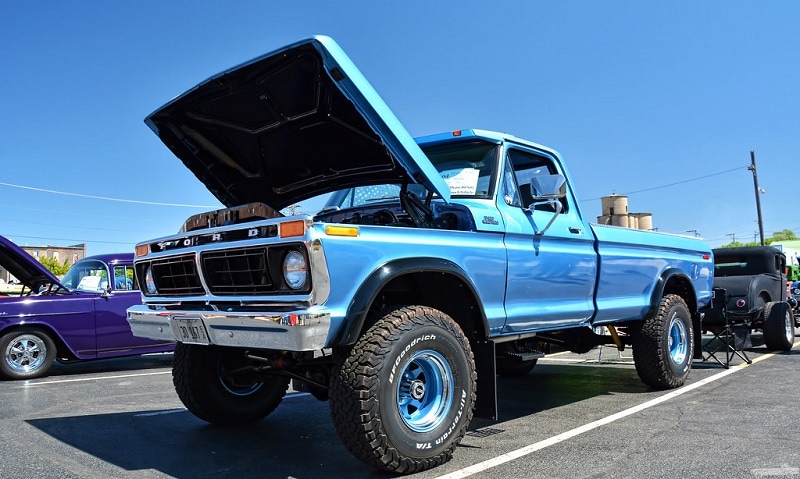
Ford’s first generation of F150 pickup trucks was part of the company’s sixth-generation of F series pickup trucks. Even though the sixth generation of the F series was introduced in 1973, it was not until 1975 that the business initially announced the new member of the family. With the F150 Ford hoped to compete with C/K trucks from General Motors.
The F150 had a gross vehicle weight rating of 6050 lb., which placed it between the F100’s 4650 to 5700 lb. and the F250’s 6200 to 8100 lb. Regular and SuperCab pickup variants were available in the F150’s cabin, with the former being the most popular. Everything was created to provide spaciousness, comfort, and a peaceful ride for passengers.
The standard cab variant featured a roomy 3-passenger truck with a full-width front seat and a cargo compartment behind the seat in the cab behind the seatback. The SuperCab, on the other hand, was a two-door pickup truck that could accommodate a family of six people. It had a 44-cubic-foot in-cab cargo compartment behind the front seat, as well as the choice of rear bench seats or jump seats.
The 300-cu.-in. (4.9-liter) I-6 engine was standard in most of the series and, naturally, in the Ford F150, which produced 113 horsepower at the time. Aside from the I-6, there were three more engine options for the F150: V-8 engines with displacements of 360 cu. in. (5.9 liters), 390 cu. in. (6.4 liters), and 460 cu. in. (7.5 liters). These produced 145, 160, and 245 horsepower, with the horsepower increasing as the engine volume increased.
A custom trim level was standard, and Ford also included a standard blend-air type heater for Ford F150 with the option of an additional high-output heater as a standard feature for SuperCab models. Air conditioning was available as an option, and it was meant to be a small system to save space.
Low Fuel Economy Warning Light was available as an option on the instrument panel, and it alerted the driver when the engine’s low vacuum was depriving it of fuel. Ford also had Pace Control, which allowed drivers to smoothly keep a consistent speed, although it was only available for cars with 460 cubic inch V-8 engines.
Continue reading related first generation Ford F-150 guides:
Ford F150 VI SuperCab 4.9 300 Six (113 hp) 1975-1979 Specs – Source: Auto-Data.net
| Seats | 6 | Number of Gears (Manual Transmission) | 3
|
| Doors | 2 | Front Suspension | Independent, spring, Transverse stabilizer |
| Power Per Liter | 23 hp/l | Rear Suspension | Leaf spring |
| Max Weight | 2744 kg (6049.48 lbs.) | Front Brakes | Disc |
| Trunk (Boot) Space- Minimum | 1727-2084 L (60.99 – 73.6 cu. ft.)
|
Rear Brakes | Drum
|
| Length | 5362-5773 mm (211.1 – 227.28 in.) | Power Steering | Electric Steering
|
| Wheelbase | 3531-3937 mm (139.02 – 155 in.)
|
Tires Size | 215/75 R15; 225/75 R15
|
| Wading Depth | 660-671 mm (25.98 – 26.42 in.) | Wheel Rims Size | 7J x 15
|
| Drive Wheel | Rear-wheel drive |
Second Generation Ford F150

The Ford F150 was introduced as part of the Seventh Generation of F-Series pickups, which marked the beginning of the Second Generation for F150. The seventh-generation was debuted in 1980 and remained on the market until 1986 when it was replaced. Because it was the first major redesign of the F-Series since the inception of the F-Series designs, it was a significant milestone.
During the 1981 model year, the Ford Pickup Models firm highlighted six reasons why customers should choose their products: long-range, aerodynamic design, new automatic overdrive, halogen headlamps, a new 4.2 L (255) V-8 engine, and rust protection.
EPA gas mileage estimates for Ford F150 and F100 pickups with standard 4.9L (300) six-cylinder engines and optional 4-speed manual transmission with overdrive were the best of any 1980 American-built standard-size pickup, excluding types of diesel.
The Ford F150’s outstanding pickup driving range was made possible by its excellent mileage and large fuel tank of 62 L (16.5 gallons). From the grille’s shape to the slope of the hood and the design of the roof, everything is well thought out.
It was decided that the Ford F150 would be revamped with aerodynamics in mind, resulting in more efficient engine utilization as compared to the previous generation. Ford F150 Regular Cab Pickups were also available with two different levels of Free-Wheeling capability.
The automatic overdrive option was offered for the V-8 5L (302) engine options in the new 1981 Ford F150. When traveling at approximately 40 mph, the transmission automatically shifts into the overdrive gear, causing the engine to turn more slowly.
For the Ford pickups, a new V-8 with six cylinders was introduced, which was billed as “the world’s smallest V-8 available in an American-built pickup.”
The pickup had standard Twin-I-Beam front suspension, a 4.9L (300 CID) engine, extensive corrosion protection, radial tires, and new halogen headlamps on the 1981 model year of the Ford F150. Its double-wall construction, Twin*I Beam front suspension, and wide, comfortable interior were all features of the Regular Cab Pickup’s construction.
The SuperCab Pickup provided more internal space and comfort. A conventional front bench seat and rear bench seat were available, providing enough space for a family of six.
The Ford F150 was also available with a variety of extra packages that included a variety of modifications. These included the Appearance, Audio, Comfort/Convenience, Seats (SuperCabs), Seat Trim, and Wheels and Wheel Covers packages, as well as the Appearance Package.
Continue reading related second generation Ford F-150 guides:
Ford F150 VII Regular Cab 4.9 Six (125 hp) 1981-1986 Specs – Source: Auto-Data.net
| Seats | 2-3
|
Number of Gears (Manual Transmission) | 3
|
| Doors | 2 | Drive Wheel | Rear Wheel |
| Power Per Liter | 25.4 Hp/l | Rear Suspension | Leaf spring |
| Max Weight | 2767 kg (6100.19 lbs.) | Front Brakes | Disc |
| Fuel Tank Capacity | 62-72 L (16.38 – 19.02 US gal)
|
Rear Brakes | Drum
|
| Length | 4770-5291 mm (187.8 – 208.31 in.) | Power Steering | Electric Steering
|
| Wheelbase | 2967-3378 mm (116.81 – 132.99 in.) | Tires Size | 215/75 R15; 235/75 R15
|
| Wading Depth | 726-732 mm (28.58 – 28.82 in.) | Wheel Rims Size | 15
|
| Drive Wheel | Rear-wheel drive |
Third Generation Ford F150
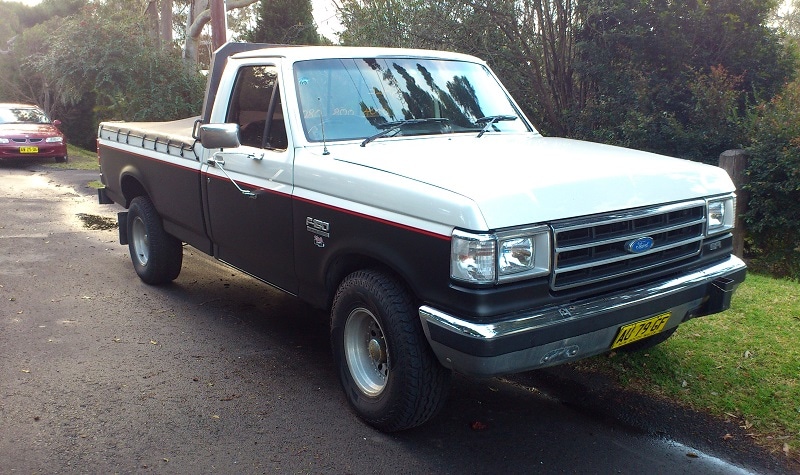
Ford’s eighth generation of F series pickups incorporated new design features for the third generation of Ford F150 pickups. New improvements were introduced in 1987, and the design remained unchanged until 1991. Before 1988, Ford collected many owner-reported faults in a series of surveys to enhance its trucks. Based on cumulative calendar year retail deliveries over the previous 11 years, the Ford F-Series was America’s best-selling truck in 1988.
The F150 was available in two cab styles: Regular and Super Cab. These might be coupled with one of three different trim levels. These trim levels likewise have three levels to choose from. As previously stated, this series of Ford F150 trucks were available in three trim levels: Custom, XL, and XLT Lariat.
The Ford F150 XLT Lariat provided first-rate comfort and elegance. Its modern appearance is enhanced by a smooth, chrome front bumper and a black rub strip. It came with aero halogen headlights with impact-resistant lenses, as well as a slew of other amenities for comfort and style. The XLT Lariat option was the most luxurious of all the F-Series cars, including the F150.
The Ford F150 XL, on the other hand, was a popular choice for those who wanted a blend of style and practicality. Aero halogen headlights were also included as standard equipment. The interior was designed with easy-to-clean fabrics and vinyl seats.
There was also the Ford F150 Custom, which was created for customers who wanted to use their truck for a range of tasks such as construction work or yard work. It could also be used for personal tasks around the house or for leisure purposes.
Continue reading related Third F-150 Generation Guides:
A Regular Cab Style Ford F150 pickup would be outfitted as follows if the XLT Lariat Trim was selected with the 507A option (highest option):
F150 Regular Cab Styleside (2WD, 4WD) Equipment Package for XLT Lariat – Source: Ford 1988 Brochure
| Minimum Cost Payload Package | Minimum Axle | Minimum BSW tires 2WD, 4WD | Custom Trim | Convenience Group |
| Auxiliary Fuel Tank | Tinted Glass | Bright Low Mount Swingaway Mirrors | Chrome Grille | Headliner and Insulation Package |
| Light Group | Electronic AM-FM Stereo With Clock | Speed Control/Tilt Steering Wheel | Sport Wheel Covers | XLT Lariat Trim |
| Air Conditioning | Power Door Locks/Windows | Sliding Rear Window |
In addition, Ford’s rear anti-lock braking system was installed on this generation of trucks, but it was only functional in 2WD mode. When the pickup’s electronic system detects rear wheel lock-up, it directs the pressure control valve to vary the hydraulic pressure in the rear brake line, preventing the pickup from sliding.
Multiple port electronic fuel injection (EFI) systems were also standard on F150 pickups with regular gasoline engines, allowing for precise fuel dosing, which resulted in improved fuel economy and a smooth start-up in extreme temperatures.
The high-cube 4.9 light 6-cylinder engine was standard on the F150, and it was the largest six-cylinder engine available in a full-size pickup at the time. Optional engines for the Ford F150 included a 5.8-liter V8 with 210 horsepower and a 5.0-liter V8 with 185 horsepower.
Ford F150 VIII Regular Cab 4.9 300 Six (145 hp) 1986 Specs – Source: Auto-Data.net
| Seats | 2-3
|
Number of Gears (Manual Transmission) | 4
|
| Doors | 2 | Fuel System | Multi-point indirect injection
|
| Power Per Liter | 29.5 Hp/L | Front Suspension | Independent, spring |
| Max Weight | 2835 kg (6250.11 lbs.) | Front Brakes | Disc |
| Fuel Tank Capacity | 62-72 L (16.38 – 19.02 US gal)
|
Rear Brakes | Drum
|
| Length | 4917-5339 mm (193.58 – 210.2 in.) | Power Steering | Electric Steering
|
| Wheelbase | 2967-3378 mm (116.81 – 132.99 in.) | Tires Size | 215/75 R15; 235/75 R15 |
| Wading Depth | 742-767 mm
(29.21 – 30.2 in.) |
Wheel Rims Size | 6J x 15
|
| Drive Wheel | Rear-wheel drive |
Fourth Generation Ford F150

In 1992, the ninth generation of the F-Series (and the fourth generation of the F150) was released. Ford resurrected the FlareSide bed in this generation to appeal to younger customers and give the F150 a more sporting appearance.
In their 1992 brochure, they promoted the F-Series with the slogan “Everyone should own a red sports car…once in their lives” That may have been true. Thirty years ago. Today, there’s a new attitude in America: Everyone should own a truck…just for the fun of it”.
Owners had the option of selecting either the sporty XLT or the stunningly different Nite vehicle. SuperCab or Regular Cab, 4×2, or 4×4 configurations were available. Ford provided a wide range of options for the F150, including three electronically fuel-injected engines and a choice of manual or automatic transmissions.
The XLT trim level of the vehicle was equipped with chrome-style steel wheels and a standard 4.9-liter EFI I-6 engine mated to a 5-speed manual overdrive transmission as standard equipment.
Nite truck, on the other hand, came with a 5.0L EFO V-8 engine and a 5-speed manual overdrive stick as standard equipment. Raven Black was the color for the Nite model. All Flaresides were equipped with standard power steering and power brakes, as well as a rear anti-lock braking system.
Ford offered more interior options for the F150 FlareSide pickups than they did for the trucks’ exteriors. Buyers could pick between the Regular Cab and the SuperCap, which both offer more than 30 cubic feet of space behind the front seat for storing golf clubs or luggage.
The flying bench seat in the Regular Cab and the optional Captain’s Chairs in the SuperCab were both covered with cloth, which helped to keep the owner cool on hot days and cool on hot days. A leather-wrapped steering wheel was included as standard equipment. The electronic AM/FM stereo and optional cassette player on the Flareside were both equipped with preset memory. Both cabs were equipped with four speakers.
Buyers of the F150 Flareside could select the 4×4 configuration for any of the available models. It was equipped with conventional locking hubs. Those were simple to use, and the driver may change modes by simply shifting to the 4-wheel in the stop position.
To be able to shift on the go, Ford introduced Electric Touch Drive, which allowed drivers to switch from 2-wheel drive to 4-wheel drive and back again.
Flareside 4x4s were equipped with a standard 2-speed transfer case, a 5-speed manual overdrive transmission, a Twin-Traction Beam front suspension, and rear axles with a towing capacity of 3,800 pounds.
Continue reading related Fourth Generation Ford F-150 guides:
Ford F150 IX SuperCab 4.9 (145 hp) 4×4 1991 Specs – Source: Auto-Data.net
| Seats | 5-6
|
Number of Gears (Manual Transmission) | 5
|
| Doors | 2 | Fuel System | Multi-point indirect injection
|
| Power Per Liter | 29.6 Hp/l | Front Suspension | Independent, spring |
| Max Weight | 2835 kg (6250.11 lbs.) | Front Brakes | Disc |
| Fuel Tank Capacity | 62-72 L (16.38 – 19.02 US gal)
|
Rear Brakes | Drum
|
| Length | 5565-5977 mm
(219.09 – 235.31 in.) |
Power Steering | Electric Steering
|
| Wheelbase | 3531-3937 mm (139.02 – 155 in.) | Tires Size | 235/75 R15 |
| Wading Depth | 848 mm (33.39 in.) | Wheel Rims Size | 15
|
| Drive Wheel | All-wheel drive (4×4) |
Fifth Generation Ford F150

The chassis received fully independent front suspension as part of the most significant upgrade of the F-Series in 17 years (the eleventh generation), signaling the end of the vehicle’s use of Twin I-Beam front axles. The 1997 F-150 shared just the transmissions with its predecessor, but it was outfitted with a range of new F-Series engines, including a 4.2 L V6 and a 4.6 L V8; a 5.4 L V8 was launched later in the year.
Ford promoted the F150 in this way, along with the distinctive FlareSide sport design, to encourage people to utilize their trucks for everyday jobs like grocery shopping and other household duties. The Ford F150 Flareside, like previous versions, was available in Regular Cab or SuperCab configurations…
On 4×2 and 4×4 models equipped with Off-Road Equipment, a specific Off-Road Equipment Group with special 17″ all-terrain tires, unique aluminum wheels, fog lamps, skid plates, and other features was available.
The Lariat model held its status in the current generation, and it came standard with a leather front 60/40 3-passenger split-bench seat with separate recliners and a center fold-down armrest/storage bin. The 60/40 rear split-bench seat is standard on SuperCab, XL, XLT, and Lariat trim levels, while it is optional on Standard.
Ford also emphasized the safety measures integrated into its trucks. The Ford F-Series was the first full-size pickup to include standard driver and right-front passenger airbags in addition to safety belts. Optional interior features for the XLT and Lariat included a six-disc CD changer, an electronic AM/FM stereo radio, and a cassette player.
The base engine was a 4.2-liter V6 that produced 205 horsepower at 4,400 rpm, making it the most powerful basic V6 available in a full-size pickup at the time. It had a split-port induction system with two valves and two intake ports per cylinder, which was unprecedented at the time. One of the vehicle’s attractions was the Triton V8 engine.
The 4.6-liter engine outperformed the V8 engine that it replaced in the previous generation of automobiles in terms of horsepower per liter of displacement. When installed in the Ford F150, this engine delivered the maximum feasible V8 payload capacity in its class.
Customers could also choose the 5.4-liter Triton V8 engine, which has the greatest horsepower and torque.
Continue reading related Fifth Generation Ford F-150 guides:
Ford F150 X SuperCab 4.9 V6 (202 hp) 1997 Specs – Source: Auto-Data.net
| Seats | 5-6
|
Number of Gears (Manual Transmission) | 5
|
| Doors | 2 | Fuel System | Multi-point indirect injection
|
| Power Per Liter | 48.2 Hp/l | Front Suspension | Independent, spring, Transverse stabilizer |
| Max Weight | 2744 kg
(6049.48 lbs.) |
Front Brakes | Ventilated discs, 308 mm |
| Fuel Tank Capacity | 95 L (25.1 US gal, 20.9 UK gal)
|
Rear Brakes | Ventilated discs, 335 mm |
| Length | 5728 mm (225.51 in.) | Power Steering | Cone worm with recirculation balls |
| Wheelbase | 3518 mm
(138.5 in.) |
Tires Size | 235/70 R16 |
| Wading Depth | 820 mm (32.28 in.) | Wheel Rims Size | 16
|
| Drive Wheel | Rear wheel drive | Assisting Systems | ABS |
Sixth Generation Ford F150
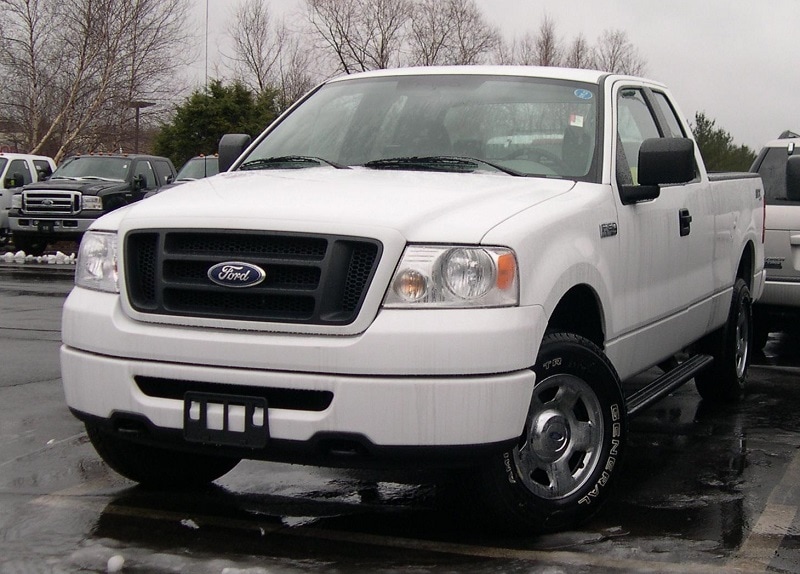
The Eleventh Generation of the Ford F-Series was revealed during the sixth generation of the Ford F150. The 2004 Ford F150 received a significant redesign. The redesign of the F150 emphasized what trucks are designed to do: work, tow, haul, climb, and carry.
The F-150 was reworked on an entirely new platform with a fully boxed-in frame and rear shocks mounted outside of the chassis for reduced wheel hop and increased ride quality.
The first-and-only 4-door Regular pickup, the first-and-only full-size pickup to employ 3-valve engine technology with 5.4 Triton V8 engine to optimize horsepower and low-end torque. It was also the first to have wheel-torque-based Electronic Throttle Control in a full-size pickup to help deliver smooth, consistent engine response. These and many more features that made F150 part of the best-selling pickups for 27 years straight were all mentioned in the 2004 product brochure.
In 2004, the sixth-generation truck had a stronger frame in comparison to its class, as well as revolutionary front and rear suspension and cab-insulating body mounts. Outboard-Mounter Rear Shocks improved comfort and handling control on difficult terrain. On uneven conditions, the double-wishbone front suspension design and cast-aluminum lower control arms provided directional control. Other features that improved control were coil-over-shock design and rack-and-pinion steering.
Ford once again demonstrated its commitment to improving pickup truck safety as well. As a result of this commitment, the 2004 Ford F150 had a Personal Safety System. It was the first full-size pickup to be named a Best Pick in the frontal offset category.
Also, on the engine, Ford’s power systems have never ceased innovating. As a standard feature, electronic throttle control on all F150 engines employed accelerator inputs to dynamically adjust torque at the drive wheels.
The new 4.2L V6 engine delivered excellent performance and was available with either a 4-speed automatic or 5-speed manual transmission. In addition to the base 4.6L engine, Ford offered the 4.6L Triton V8, or the 5.4L 3-valve Triton V8 for the Ford F150.
Ford F150 XI Regular Cab 4.9 V6 (202 hp) Automatic 2005 Specs – Source: Auto-Data.net
| Seats | 3 | Number of Gears (Automatic Transmission) | 4
|
| Doors | 2 | Fuel System | Multi-point indirect injection
|
| Power Per Liter | 48.2 Hp/l | Front Suspension | Double wishbone |
| Max Weight | 3016 kg
(6649.14 lbs.) |
Front Brakes | Ventilated discs, 330 mm |
| Fuel Tank Capacity | 98 – 135 L (25.89 US gal, 35.66 UK gal)
|
Rear Brakes | Ventilated discs, 348 mm |
| Length | 5364-5837 mm (211.18-229.8 in.) | Steering | Steering rack and pinion |
| Wheelbase | 3200-3670 mm
(125.98-144.49 in.) |
Tires Size | 235/70 R17; 265/60 R18 |
| Position and number of cylinders | V-engine, 6 cylinders, SOHC | Wheel Rims Size | 17;18 |
| Drive Wheel | Rear-wheel drive | Assisting Systems | ABS |
Seventh Generation Ford F150
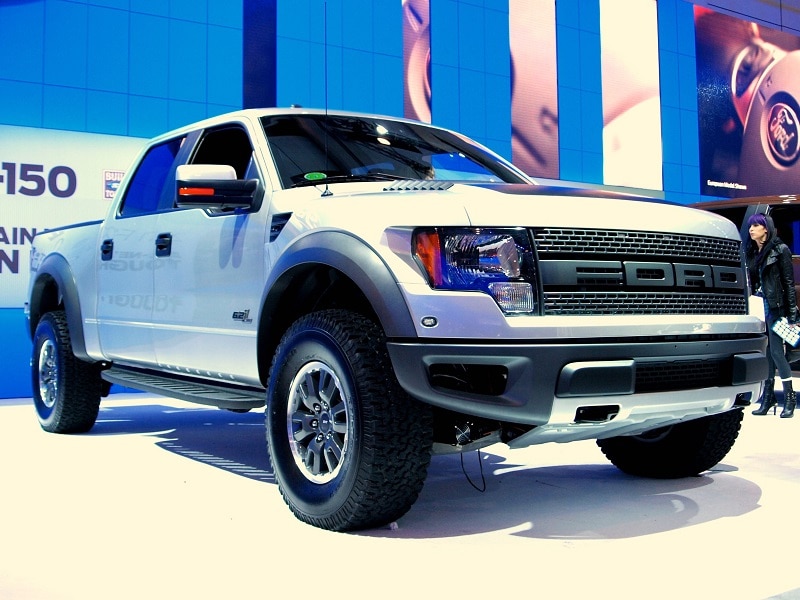
From 2009 until 2014, Ford sold the twelfth generation of F-Series pickup trucks, which were available from the company. Although the Ford F150 Flareside was offered in this series, it was discontinued in 2010, along with the manual transmission.
In addition, a new model SVT Raptor was added to the list of available options for the F150 in 2010. The new Ford F150 from 2009 was a model that benefited from the technical advancements of the twenty-first century.
- When the seventh generation of Ford F150 vehicles was introduced, the frame was one of the features that stood out: it had the widest rear leaf springs in its class while still being 6 inches longer. This resulted in increased axle control, which allowed the driver to achieve a balance between ride smoothness and best-in-class load capacity.
- New twin-tube shocks at all four corners contribute to a more refined ride and better control in a variety of road conditions.
- The F150’s class-leading capabilities were built on a fully boxed, ladder-style frame that was completely enclosed.
- Fully boxed cross members were used to form the new flat load floor, and their strength was maximized by placing them precisely where they were needed.
- Control arm bushings were used in the front coil-over-shock suspension design to provide more lateral stiffness, but the system maintained its smooth ride and responsive steering performance.
Ford continued to improve the power capabilities of its engines, while also attempting to make them even more efficient, much as it had done in previous models.
Ford Brochure from 2009
| Powertrain | Max. MPG | Max Payload (lbs.) | Max Towing (lbs.) |
| 4.6L 2-Valve V8/4 Speed | 19 | 1,890 | 6,000 |
| 4.6L 3-Valve V8/6 Speed | 20 | 1,930 | 9,500 |
| SFE Package 4.6L 3-Valve V8 | 21 | 1,620 | 7,500 |
| 5.4L 3-Valve V8/6-Speed | 20 | 3,030 | 11,300 |
Powered by a 4.6L 2-Valve V8 engine mated to a 4-speed automatic transmission, the Ford F150 had a standard powertrain that produced 248 horsepower and 294 pound-feet of torque, which was a 22 percent increase in horsepower while maintaining the same fuel economy as the previous base V6 engine and automatic transmission.
New 4.6 3-valve V8 with new 6-speed automated transmission provided an excellent balance of power and fuel efficiency. It has 292 horsepower and 320 pound-feet of torque, and it gets 21 miles per gallon when configured and adjusted for the F150.
In addition, a more powerful 5.4L V8 with 320 horsepower and 390 lb.-ft. of torque was included in the options, which was paired with a new 6-speed automatic transmission. As a result of this improved configuration, the maximum towing capability has been enhanced significantly.
Ford’s SFE package, on the other hand, was designed to achieve great efficiency and the best-predicted gas fuel economy of 15 mpg city/21 mpg highway, according to the Environmental Protection Agency (EPA).
Tow Capacity Source: Ford Brochure from 2009
| Max Towing (lbs.) | Regular Cab | SuperCab | SuperCrew |
| 4.6L 2-Valve V8/4 Speed | 6,000 | 5,800 | 5,700 |
| 4.6L 3-Valve V8/6 Speed | 8,400 | 9,500 | 9,500 |
| 5.4L 3-Valve V8/6-Speed | 11,300 | 11,300 | 11,300 |
| Max Payload (lbs.) | |||
| 4.6L 2-Valve V8/4 Speed | 1,890 | 1,610 | 1,620 |
| 4.6L 3-Valve V8/6 Speed | 1,930 | 1,650 | 1,690 |
| 5.4L 3-Valve V8/6-Speed | 3,030 | 2,650 | 1,760 |
The digital and networking features of the Ford F150 in its seventh generation were one of the most significant upgrades to the pickup’s cabin in its seventh generation. In addition to voice-activated communications and entertainment systems, Ford Sync powered by Microsoft included Bluetooth connectivity for connecting to a mobile phone.
In contrast, the Sirius trip link was a GPS that was included in the package price. The advanced navigation radio option, which worked with voice instructions and responded to the driver with turn-by-turn directions, was equipped with an 8-inch screen and a CD/DVD player, among other features.
Finally, Ford’s commitment to improving safety can be demonstrated once more in this series of F150 trucks. Several new features were added to the seventh generation Ford F150 including hydroformed front structures, high-strength steel roof bows, head restraints, seats, and new boron steel-reinforced b-pillars.
Ford F150 XII Regular Cab 4.6 V8 (248 hp) Automatic 2008 Specs – Source: Auto-Data.net
| Seats | 3 | Number of Gears (Automatic Transmission) | 4
|
| Doors | 2 | Fuel System | Multi-point indirect injection
|
| Power Per Liter | 53.8 Hp/L | Front Suspension | Double wishbone |
| Max Weight | 3152 kg
(6948.97 lbs.) |
Front Brakes | Ventilated discs, 330 mm |
| Fuel Tank Capacity | 98 L (25.89 US gal, 21.56 UK gal)
|
Rear Brakes | Ventilated discs, 348 mm |
| Length | 5413-5885 mm (213.11 – 231.69 in.) | Steering | Steering rack and pinion |
| Wheelbase | 3200-3670 mm
(125.98-144.49 in.) |
Tires Size | 255/70 R17; 275/65 R18 |
| Position and number of cylinders | V-engine, 8 cylinders | Wheel Rims Size | 17;18 |
| Drive Wheel | All wheel drive (4×4) | Assisting Systems | ABS |
Eighth Generation Ford F150
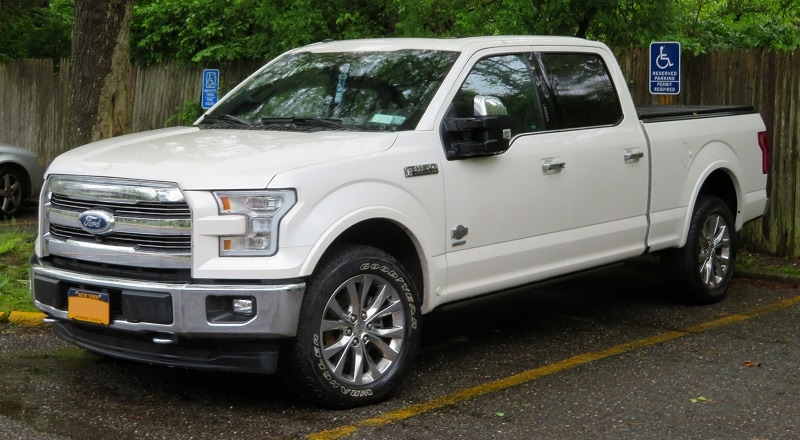
The eighth generation of the Ford F150 is a relatively fresh model. Which was spanned the years 2015 through 2020. Throughout the development of the F150, Ford improved the frame’s strength as production processes improved and design and analysis grew easier.
The new fully boxed modular frame is composed of up to 78 percent high-strength steel, according to the manufacturer. Eight robust cross-members and large cross-section rails provided the new, extremely rigid construction, which was stronger and sighter than any other in the F150’s historical record. High-strength aluminum alloys, on the other hand, allowed Ford to reduce the overall weight of the pickup truck by a significant amount.
When Ford’s F150’s less weight is combined with improved engine performance, the vehicle’s power-to-weight ratio is drastically improved. This contributed to the Ford F150 obtaining an estimated highway fuel economy rating of 26 mpg2, according to the EPA estimations. In the evolution of Ford F150 pickups, the launch of the all-new 2.7L EcoBoost engine marked yet another big step forward.
The Ford F150’s power-to-weight ratio has been dubbed “Pocket Hercules,” and the engine’s power output is 13 percent greater than that of a V8-equipped 2014 F150 with comparable torque output. The 2015 Ford F150 has a maximum towing capacity of 12,200 pounds and a maximum payload capacity of 3,300 pounds, respectively (Lariat Super Crew 4×4).
2015 Ford F150 had four available engine options:
2015 Ford F150 Engine Options – Source: Official Brochure
| 3.5L TI-VCT V6 | 2.7L ECOBOOST V6 |
| Designed for high power and durability. Twin Independent Variable Camshaft Timing provides torque across a wide rpm range.
|
Designed to deliver power and performance in a stronger, smarter package.
|
| 3.5L ECOBOOST | 5.0 TI-VCT V8 |
|
|
Ford also improved the brake system and incorporated electric power-assisted steering, as well as the curve control, which improves control when entering turns. Interior design, on the other hand, was unquestionably one of the many things that had a significant difference because of the advancement of technology.
The 20015 Ford F150 was equipped with a 360-degree vision camera and Splitview Display. The park system had four cameras that allowed drivers to see around them, and a blind spot system that made it both safer and easier to drive.
Ford F150 2015 came in five different trim levels, each with a fully new interior: XL, XLT, LARIAT, KING RANCH, and PLATINUM.
| Regular Cab | SuperCab | SuperCrew | |
| XL | Standard | Optional | Optional |
| XLT | Standard | Optional | Optional |
| LARIAT | Standard | Optional | |
| KING RANCH | Standard | ||
| PLATINUM | Standard |
Ninth Generation Ford F150

Finally, the 14th generation of F-Series trucks arrived in 2021, along with the latest generation of Ford F150. It had a similar appearance to the previous version, but it had a major redesign for its parts, with only the cab and pickup framework from the previous generation being used.
Buyers of the New Ford F150 2021 can also select from a wide range of options. Six trim levels are ranging from XL to LIMITED, six engines, three cabs, three box lengths, and numerous cosmetic packages to pick from. The truck includes a 10-speed automatic transmission and a body and box made of high-strength military-grade aluminum alloy.
Ford designed the new F150 with the same idea as the previous edition, utilizing the benefits of growing technology and incorporating F-150 accessories that make it easier to tow, transport, or utilize the truck for daily tasks. These innovations include an optional 360-degree camera and novel concepts such as Pro Power Onboard, which provides power when you are not near a power source.
It offers 2.0 kW, 2.4 kW, and 7.2 kW systems, allowing you to select the output that best suits your needs. Ford, on the other hand, continues to improve its driver assistance systems with Ford Co-Pilot360 Technology, which includes auto hold, auto lamp, lane-keeping systems, pre-collision help with emergency braking, and a rear-view camera with dynamic hitch assist capabilities.
Ford has increased the number of engine options available for the F150 on the engine side. Ford believes that the new 3.5L PowerBoost Full Hybrid engine is a revolution in the automotive industry:
| New 3.5L Powerboost Full Hybrid V6
|
3.0 L Power Stroke Turbo Diesel
|
3.5L Ecoboost
· 400 Max. Horsepower · 500 lb.-ft. of Torque
|
| 5.0 Ti-VCT V8
|
2.7L Ecoboost
|
3.3L Ti-VCV V6
|
When it comes to the interior, Ford opts for a sporty design. The new interior prioritizes comfort, productivity, and convenience above everything else. Upper gloveboxes, large door storage pockets, new colors, new materials for the seats, console storage pockets, new headrest speakers, a flat cargo floor, and a new rear under-seat storage compartment are all part of the new interior design. A Bang & Olufsen sound system with an eight-speaker system is also available to buyers.
Regarding the digital instrument cluster, the Ford F150 boasts a new 12″ digital instrument cluster that includes full digital gauges as well as a responsive big message center. Owners will be able to use Apple Car Play or Android Auto as well with the added wireless capacity, further enhancing the connectivity of the vehicle, which is screened through the new 12é center stack system. The SYNC system has also been upgraded to SYNC 4 to go along with the new vehicle.
It is available in XL/STX, XLT, LARIAT, KING RANCH, PLATINUM, and LIMITED trims, with three cab types: Regular Cab, SuperCab, and SuperCrew. It is also available in XLT and LARIAT trims.
Continue reading related Ninth Generation Ford F-150 guides:
Ford F150 XIV SuperCab 2.7 EcoBoost V6 (325 hp) 4×4 Automatic 2021 Specs – Source: Auto-Data.net
| Seats | 5-6 | Number of Gears (Automatic Transmission) | 10 SelectShift |
| Doors | 2 | Fuel System | Direct injection / Multi-point indirect injection |
| Power Per Liter | 120.4 Hp/L | Front Suspension | Double wishbone |
| Max Weight | 3175 kg (6999.68 lbs.) | Front Brakes | Ventilated discs, 350×34 mm |
| Fuel Tank Capacity | 87-136 L (22.98 – 35.93 US gal | 19.14 – 29.92 UK gal)
|
Rear Brakes | Ventilated discs, 336×20 mm |
| Length | 5885mm (231.69 in.) | Steering | Steering rack and pinion |
| Wheelbase | 3693 mm
(145.39 in.) |
Tires Size | 245/70 R17 110T; 265/70 R17 115T; 265/60 R18 110T; 275/65 R18 116T |
| Position and number of cylinders | V-engine, 6 cylinders | Wheel Rims Size | 7.5J x 17; 7.5J x 18 |
| Drive Wheel | All wheel drive (4×4) | Assisting Systems | ABS |
Ford F150 Closest Alternatives
Even though the Ford F150 is a wonderful truck, you may want to examine other options that are frequently compared to the Ford F150. Listed below are some of the models you might want to look at before committing to the F150:
Toyota Tundra
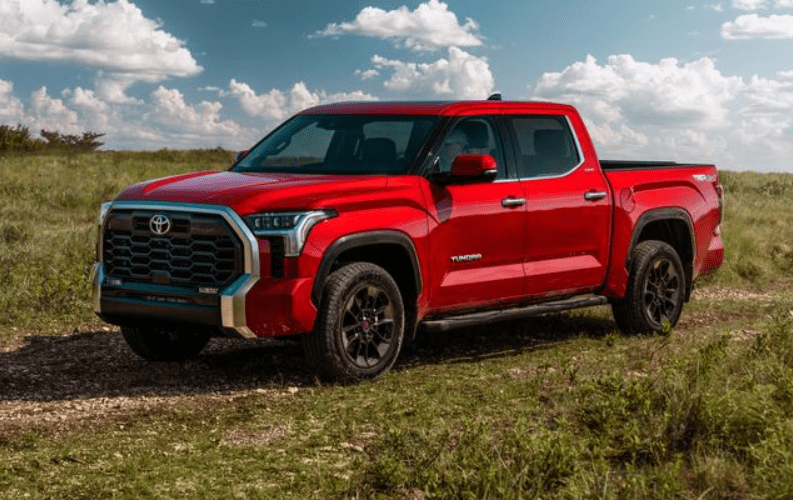
Because of its reliability, the Toyota Tundra is becoming increasingly noteworthy. It should come as no surprise that Toyota is offering this vehicle, as the company is well-known for producing reliable vehicles. It is not just the truck’s dependability that is enhanced by its intimidating appearance but also the curiosity of those who see it. A sophisticated premium interior does not have to be compromised for an aggressive and dominating exterior, according to the Toyota Motor Corporation.
When it comes to the Tundra’s exterior, it was built to get the job done while also looking good doing it. This full-size pickup, which is available in 4×4 Double Cab and 4×4 CrewMax configurations, provides a selection of one-of-a-kind packages to enhance the appearance and capabilities. 2022 Tundra starts with the $35,950 price tag for the SR model.
Continue reading our full Toyota Tundra vs Ford F-150 Comparison.
Ram 1500
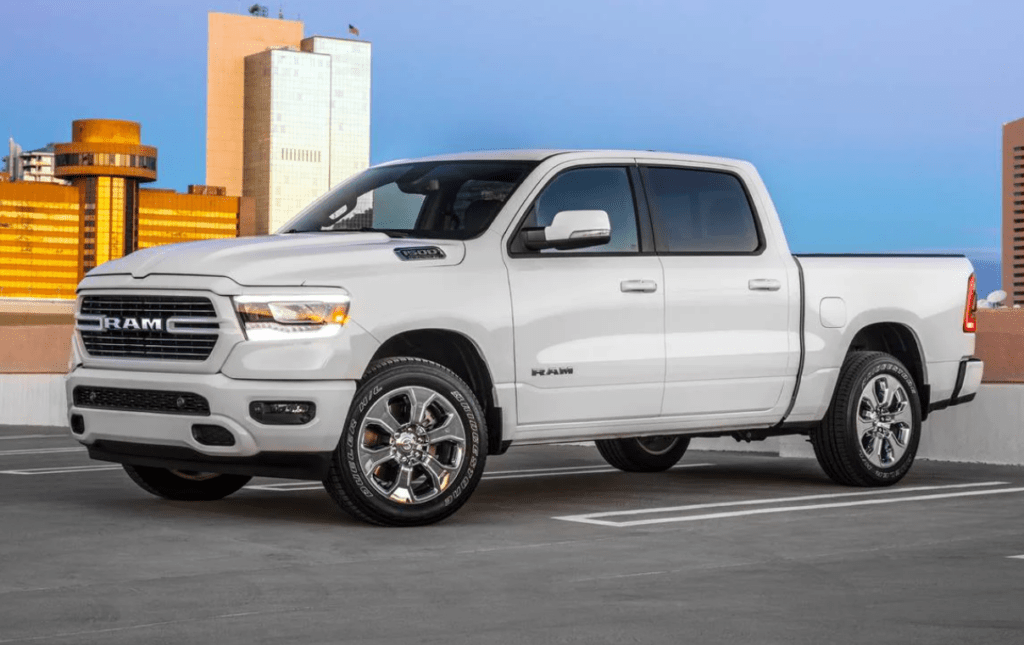
The Ram 1500, on the other hand, may take you by surprise. According to many, the Ram 1500 is a very capable truck that provides high levels of customer satisfaction. Because of the sophisticated suspension, which can be made cushier with the available air springs, and increased comfort, the 2022 Ram 1500 provides a more pleasurable and enjoyable ride.
In addition to the 12.0-inch touchscreen, Ram’s 1500 includes a split-folding tailgate and cargo bed compartments. Both the V-8 engine and the hybrid assistance system are available for this model. 2022 Ram 1500 is starting at $36,195.
Chevy Silverado

Because of its sleek and elegant cabin, as well as its self-driving capability, which allows it to tow a trailer, the 2022 Chevrolet Silverado is quickly becoming a household name. Engine options range from the turbocharged four-cylinder to the six-cylinder diesel to the massive 6.2-liter V-8, and they’re all just as powerful as they’ve always been for Chevrolet.
When utilized in the field, it has a towing capability of 13,300 pounds and may be supplied with a range of high-tech trailering aids to make towing more efficient. Despite its stifling ride and other shortcomings, the 2022 Chevrolet Silverado manages to keep up with its competitors in terms of performance and efficiency. It has a starting price of $30,095.
Nissan Titan
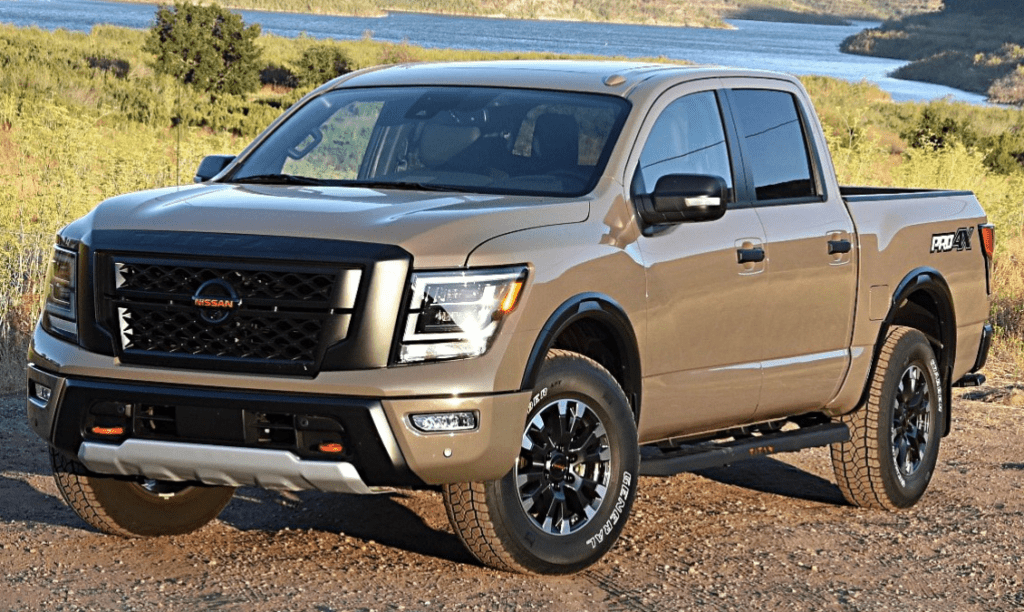
Although it starts at $39,000, it is a little more expensive than the previously stated vehicles, but it is a capable and competent full-size truck all the way around. Titan, for example, receives less attention than some of the other options, but it is still worth considering. It boasts a nice V-8 engine, as well as a good and comfy interior.
FAQ: Frequently Asked Questions
Question: Is the Ford F-150 a good truck?
Answer: Without a doubt, the Ford F150 is a solid vehicle with a great reputation and is always being improved by the Ford company. According to Ford, the F150 has been the best-selling vehicle in its class for many years, and it is targeted at customers who use their truck for a variety of tasks.
Question: How much will the 2021 Ford F-150 will cost?
Answer: The current pricing of a 2021 Ford F-150 starts at $29,290 for the F150 XL and goes up to $64,145 for the F-150 Raptor. You can reach to prices from following link: https://www.ford.com/trucks/f150/pricing-and-incentives/
Question: What engines come in the 2004 F150?
Answer: In 2004 Regular Cap had 4.6 V8 Triton (231 Hp), 5.4 V8 Triton (300 Hp). Additional engines came in 2007.
Question: What does the F stand for in F-150?
Answer: It may lead you to believe that it cannot be that simple, but Ford is the letter F. As an example, in their World War II trucks, they were numbering vehicles with numerals such as F-1, F-2, and so on. As a result, Ford retained this system and continued to use it for other models.
Ford F150 Conclusions
The Ford F150 is unquestionably a fantastic pickup truck. There are a variety of causes for this, of course, but we can plainly see that it is enhanced by experience. Ford has been manufacturing trucks and not only trucks but all types of vehicles for a very long time.
It should come as no surprise that the Ford F150 has been the most popular pickup truck in its class in the United States for a very long time.
Based on the information provided, it can be concluded that Ford is extremely committed to customer satisfaction and is not eager to cede its position to competing businesses.
Constant improvement manifests itself in the effective application of modern manufacturing, design, and material technologies of the twenty-first century.
We can see that they are attempting to catch hybrid technology on the engine side as well as the interior of the truck, which is equipped with cutting-edge technology. Of course, as with any truck, some models may experience small chronic issues, but the Ford F150 is an excellent pick.
Optional packages are available in a variety of sizes, which adds to its appeal. Other manufacturers, on the other hand, are always upgrading their products, and customers may be able to find attractive deals from companies such as Toyota, which is well-known for the dependability of their trucks.
Overall, it can be claimed that the Ford F150 is a thrilling and legendary pickup truck. Buyers can customize the vehicle to their specifications and select from a variety of engine options.
Another advantage of such a vehicle is the fact that there are numerous used Ford F150 alternatives available. As a result, we can conclude that there is an F150 that is suitable for everyone.
References
- F. (n.d.). Auto-Brochures | Ford Car & Truck PDF Sales Brochure/Catalog/Flyer/Info. Auto-Brochures | Ford Car & Truck PDF Sales Brochure/Catalog/Flyer/Info – Auto Brochures
- A. (n.d.). Ford F-Series F-100/F-150 | Technical Specs, Fuel Consumption, Dimensions. Ford F-Series F-100/F-150 | Technical Specs, Fuel consumption, Dimensions – Auto Data
- F. (n.d.). Ford Brochures By Hans Tore Tangerud Archive . Ford Brochures
- Cole, A. (2020, June 26). The Ford F-150 Pickup Truck Over the Years: A Brief History. Motor Authority. Motor Authority
- News, F. (2017). Ford. FORD CELEBRATES 100 YEARS OF TRUCK HISTORY — FROM 1917 MODEL TT TO 2017 F-150 RAPTOR. Ford Media
- Jones, K. (2020, July 22). History Of the Ford F-150. MotorTrend. Motortrend
- Wendler, A., & Irwin, A. (2021, May 20). The History Of Ford’s F-Series Pickup Truck, From the Model TT To Today. Car and Driver. Car and Driver
- Skwarczek, M. (2019, October 15). The Meaning Behind the Ford F-Series Name. MotorBiscuit. Motor Biscuit
- Stafford, E. (2021, July 15). 2022 Ram 1500 Review, Pricing, And Specs. Car and Driver. Car and Driver
- Dorian, D. (2021, December 15). 2022 Ford F-150 Review, Pricing, And Specs. Car and Driver. Car and Driver
- R. (n.d.). Ram Trucks | Build & Price Yours Today. Ram Trucks | Build & Price Yours Today. Ram Trucks
- T. (n.d.). 2022 Toyota Tundra | Engineered For Adventure. 2022 Toyota Tundra | Engineered For Adventure. Toyota Official
- Brennan, S. (2021, April 9). Skip the Ford F-150 And Choose One Of These Alternatives Instead. MotorBiscuit
- 2005 Toyota 4runner Guide - July 22, 2022
